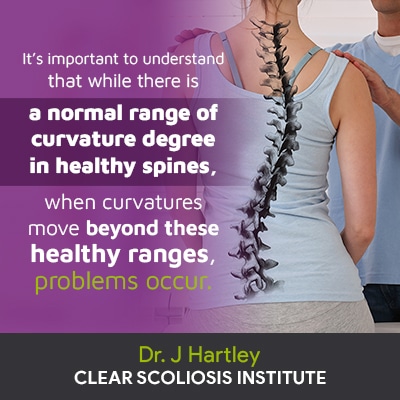
The spine is naturally curved at the neck, chest, and lower back, but if one of these curves becomes under- or over-pronounced, it can disrupt the biomechanics of the entire spine. Kyphosis and scoliosis are both spinal conditions that involve unhealthy and unnatural spinal curvatures, but scoliosis is characterized by an abnormal sideways curvature, while kyphosis involves an abnormal front-to-back curve.
The spine has three main healthy curves. With kyphosis, the upper back’s natural front-to-back curvature becomes excessive, often giving the appearance of rounded shoulders and slouching posture. Treatment options include proactively working towards a reduction of the spine’s kyphotic curve.
There are different types of kyphosis a person can develop, but before we move on to the different forms and treatment options, let’s consider why the spine is curved in the first place.
Before discussing the specifics of any spinal condition, it’s always helpful to touch on some basic spinal anatomy; that way, it’s clearer what is happening to the spine as it develops an abnormal curvature and how that abnormal curvature can affect the spine’s overall health and function.
The spine has three main spinal sections, each with its own characteristic curvature: cervical (neck), thoracic (middle and upper back), and lumbar (lower back).
When viewed from the side, a healthy spine will have a soft ‘S’ shape; when viewed from the front, it will appear straight.
The spine’s natural curvatures make it stronger, more flexible, and helps to evenly distribute mechanical stress that’s incurred during movement.
The spine is made up of rectangular-shaped bones called vertebrae. These bones are stacked on top of one another and separated by intervertebral discs. The discs perform many important functions, and their health is important for maintaining the spine’s natural and healthy curves.
The natural curvatures of the spine either bend forward or backward, known as lordosis and kyphosis.
‘Lordosis’ and ‘kyphosis’ refer to curvature types. Curvatures that bend forward, towards the body’s center in a ‘C’ shape, are lordotic curves, while curvatures that bend backward, away from the body’s center, in a reverse ‘C’ shape, are known as kyphotic curves.

Kyphosis
A healthy kyphotic range of the thoracic spine would fall between 20 and 50 degrees, and when the section’s curvature exceeds 50 degrees, this is commonly diagnosed as ‘hyperkyphosis’, or simply ‘kyphosis’.
With an over-pronounced forward curvature, the upper back can become excessively rounded, with the shoulders and upper back appearing slouched forward.
While kyphosis can develop at any age, it commonly affects adolescents, due to the stage of puberty characterized by growth spurts and rapid bone growth. It can also develop in older adults as their spines face degenerative changes associated with aging.
Kyphosis can range in severity, and while every case is different, generally, the larger the kyphotic curve, the more severe the condition is, and the more noticeable its symptoms are likely to be.
Symptoms can range between mild or no back pain with little or no postural changes, to noticeable pain and postural changes. In more severe cases, the upper back can develop a visible arch.
Kyphosis, and spinal conditions in general, are not commonly painful in young patients who have not yet reached skeletal maturity; this is because a growing spine is always being lengthened, and this counteracts the compressive force of an abnormal spinal curvature.
In adults, as their spines are no longer growing, they are vulnerable to the curvature’s compression of the spine and its surrounding vessels, muscles, and nerves.
In addition to different severity levels, there are also multiple types of kyphosis a person can develop, and causation will vary based on condition form.
The three most common forms of kyphosis are those that affect children and adolescents: postural, congenital, and Sheuermann’s. Let’s talk about what makes these forms different, including causation and treatment.
Postural kyphosis is the most common type and is also the simplest to treat; this is because, as the name indicates, the condition is caused by chronic bad posture, and not a structural abnormality within the spine itself.
This form commonly presents as slouching and overall poor posture with kyphotic curves often having a smooth and rounded appearance. When a condition is postural, if a person was to make an active effort to stand up straighter, the curvature could be corrected, as is the case with postural kyphosis.
As this type of kyphosis is most commonly found in adolescent girls, it is rarely painful because growth is still occurring. This form isn’t associated with progression and/or causing problems later in life, as long as the bad habits causing it are addressed.
Effective treatment includes addressing the cause, which is postural, so exercises and stretches that encourage healthy posture can be effective at restoring the spine’s natural and healthy kyphosis.
Congenital kyphosis affects infants, as the condition develops in utero and they are born with it. This form is caused by a malformation in the spinal column that can involve the spinal vertebrae not forming properly, or multiple vertebrae fusing together, rather than developing into separate vertebrae as they should.
This form is structural, meaning it’s more challenging to treat than postural kyphosis as the condition has to be impacted on a structural level in the form of a curvature reduction.
While every case is unique, congenital kyphosis tends to progress with growth and maturity, which is why it’s important to treat it proactively.
While there are unique challenges involved with treating infants and young children, here at the CLEAR Scoliosis Institute, our treatment approach is fully customized and integrative; we can design a treatment plan that accounts for the specifics of working with young children, including monitoring for progression and working towards a curvature reduction.
Named after the Danish radiologist who first described the condition, Scheuermann’s kyphosis is also structural in nature, making it more likely to cause problems later in life, if left untreated.
Much like postural kyphosis, Scheuermann’s kyphosis is commonly diagnosed during adolescence, and is generally more noticeable in patients who are thin.
As Scheuermann’s kyphosis is structural, this means the vertebrae of the spine are misshapen, impairing the spine’s ability to maintain its natural and healthy curvatures.
As mentioned earlier, healthy vertebrae are rectangular in shape, allowing them to be stacked neatly in a proper alignment, on top of one another, separated only by the intervertebral discs. In patients with Scheuermann’s kyphosis, an X-ray taken from the side will show multiple consecutive vertebrae that are, instead, triangular in shape.
The misshapen vertebrae impair the spine’s ability to maintain its alignment, developing an abnormal curvature as a result. Their irregular shape makes them wedge together towards the front of the spine, decreasing disc space and resulting in an excessive forward curvature of the spinal area affected, most commonly the upper portion of the thoracic spine.

Scheuermann’s kyphosis can be painful in adults, but it’s more commonly diagnosed in children and adolescents, for whom pain is not a common symptom. In adults, pain is most likely to be felt at the apex of the kyphotic curve (the most-tilted vertebrae). In addition, as the spine tends to respond to the development of unhealthy curves by putting in counteractive curves, pain can also be felt in the lower back.
Patients with kyphosis-related pain often find it worsens during long periods of sitting, standing, and/or during movement.
When it comes to treatment, here at the Institute, we offer patients a chiropractic-centered approach that proactively works towards impacting the condition on a structural level, in the form of a curvature reduction.
Our customized treatment plans also include corrective bracing, when needed, and a variety of exercises and therapies for increasing core strength to provide the spine with better support and stabilization via its surrounding musculature.
As mentioned, the spine can develop a number of conditions that involve a loss of one or more of its healthy curves, including scoliosis.
The spine is an important part of the body. It holds up the head, allows us to stand upright, maintain good posture, provides the body with structure, and enables us to bend and twist.
The spine’s optimal function, however, depends on its ability to maintain its healthy alignment and natural curvatures.
As mentioned, there are a number of different unhealthy curves a spine can develop: some that involve an excessive inward curvature, others an excessive outwards rounding of the spine, and some that curve to the side.
As a highly-prevalent spinal condition affecting approximately 7 million people in the United States alone, scoliosis involves an abnormal sideways curvature of the spine that also rotates.
While kyphosis and scoliosis share some obvious similarities, as both conditions involve developing an unnatural spinal curvature, have different forms and causes, are commonly diagnosed in adolescence, and have progression as a variable, there is an important difference; scoliosis is an abnormal sideways spinal curvature, while kyphosis is a forward-rounding of the back, most commonly the upper back, that gives patients a slouching posture.
Treatment for both scoliosis and kyphosis will depend on a number of important patient and condition characteristics such as age, curvature location, condition severity and type.
It is possible to have both scoliosis and kyphosis, and when this is the case, it means the person has at least one abnormal curve in both the sagittal plane (side view) and the coronal plane (viewed from the front or back). When this happens, it’s commonly referred to as ‘kyphoscoliosis’ or ‘scoliosis with a kyphosis’.
In structural conditions like kyphosis and scoliosis, any effective treatment plan has to impact the condition on a structural level, first and foremost, and be fully customized to address the specifics of each patient and their condition.
Through a series of targeted chiropractic adjustments, we can work towards returning the tilted vertebrae of the curvature back into a proper alignment with the rest of the spine, and when combined with a variety of condition-specific exercises and therapies, the muscles closely surrounding the spine can be strengthened to provide it with optimal support and stabilization.
Kyphosis is an excessive forward-rounding of the spine, most commonly in the upper section of the thoracic spine. This presents clinically as slouching and overly-rounded shoulders. In severe cases, the upper back can develop a visible arch.
While there is a range in the degree of healthy kyphotic curves, if a curve develops outside of that healthy range, it becomes exaggerated and excessively rounds the spine in the affected area.
While the condition is not commonly painful in children and adolescents who are still growing, adults can experience varying levels of back pain. Pain levels and related postural changes can range from mild to severe, based largely on important patient/condition characteristics such as age, condition type and severity.
Common forms of kyphosis include postural, congenital, and Scheuermann’s, and with the exception of postural kyphosis, kyphotic curves develop due to a structural abnormality such as misshapen vertebrae.
When it comes to the similarities between kyphosis and scoliosis, they are both structural spinal conditions that can be progressive, have different forms, different severity levels, can produce postural changes, and patient age plays a large role in determining whether or not the condition is painful. The main difference between the two is in curvature type; scoliotic curves bend to the side and rotate, while kyphotic curves bend forward.
Here at the CLEAR Scoliosis Institute, we assess each individual patient and their specific condition for a fully-customized treatment approach. Reach out to us here if you are concerned that you or someone you care about is developing an abnormal spinal curvature as there are multiple treatment benefits related to early detection.
Clear-institute.org - Scheuermann’s Disease
OrthoInfo - Kyphosis (Roundback) of the Spine
Spine-health.com - Thoracic Kyphosis: Forward Curvature of the Upper Back

CLEAR provides a unique and innovative way of understanding scoliosis. Sign up to receive facts and information you won’t find anywhere else.

thank you for sharing information about kyphosis, it's really helpful for the reader.